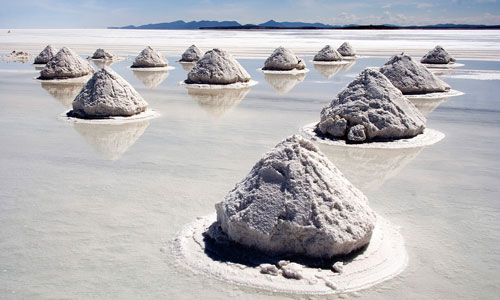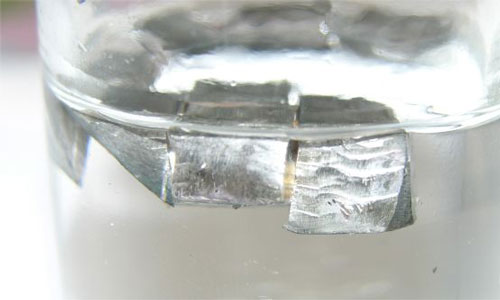Lithium's on Fire
Could lithium become the new gold, or even the new oil? The increasing need for rechargeable lithium-ion batteries may change the world's mineral appetite.
9M

Our best method of acquiring lithium involves pulling it from saltwater
The reason that the Uyuni Salt Flat is suddenly such a valuable source of lithium has a lot to do with how lithium is acquired in most cases. While it's possible to cull it from traditional mining methods, it's more effective to simply take saltwater, or brine, let it evaporate, and then separate out the lithium and other elements through the usage of chemicals.
The salt flat, a dried up lake, still has lots of underground water, and that water has a much higher concentration of lithium than most types of salt water out there, which is why Bolivia is sitting on a gold mine that could make one day make it as powerful as Saudi Arabia on the world stage.
Rodinia Lithium, a Canadian lithium-production firm with major interests in nearby Argentina, notes that extracting lithium from brine is so effective that other methods of lithium production seem wasteful in comparison.
"The economics of obtaining lithium carbonate from brine are so favorable that most hard rock production has been priced out of the market," the company explains.
The rising popularity of brine-based mechanisms for extracting lithium led to a period when the U.S. had stopped producing lithium, despite having one of the largest supplies in the world in Kings Mountain, North Carolina. (The reason? That mine's supply was extracted from the mineral spodumene using a much more complex process. It's still around, and even got some assistance from the federal government in 2009, but its output is dwarfed by the South American mines.)
But there's still room for the U.S. to make a comeback on the lithium front—and we can thank Tesla Motors for that. Back in September, the car company, which is going to be producing giant lithium-ion batteries in its Nevada-based Gigafactory. That factory is roughly 200 miles away from a planned lithium mine in Esmeralda County, Nevada, and back in September, Tesla Motors announced a deal with Pure Energy Materials, the company behind the project, to help supply lithium for its car batteries.
They'll be digging deep into the brine, shipping the raw materials to Tesla Motors, and helping to make a bunch of batteries.
Great, but will it be enough lithium for all the electric cars on the road?
"If all cars are to become electric within 50 years, fears of a crunch in lithium resources—and thus a staggering price increase such as that faced today with fossil fuels—are permeating."
— Jean-Marie Tarascon, a professor of chemistry at the Collège de France in Paris, writing in a Nature Chemistry article about the potential of a "gold rush" in the world of lithium, due to the ever-increasing demand being driven both by the increase in popularity of lithium-ion batteries in electronics and the growing interest of such batteries for use in electric cars and for industrial uses. Tarascon notes that we simply aren't producing enough lithium to account for all the batteries we're going to need down the line. "This alarming global situation will hopefully drive researchers to investigate new battery technologies and loosen our dependence on lithium," he added.

Could lithium become the 21st century version of gold?
So here we have this material that's relatively common but not the easiest thing in the world to procure, that has a lot of key benefits to multiple industries. (Kurt Cobain wasn't singing about lithium's ability to charge his iPhone, just an FYI—he was singing about its value as a mental health drug.)
That's got investors focused on raw materials seeing dollar signs. A key example of this is the site OilPrice.com, which generally covers the oil industry but has given extra attention to lithium in recent months thanks to evidence that the material could become a huge boon as the electric car industry ramps up.
"Not since the shale boom have we seen a market transformation of such significance," author James Stafford writes with the excitement of a man who has bet the farm on a wacky metal. "Lithium has long been used for a variety of mundane purposes, and while the variety is spectacular—with applications in everything from glass, ceramics and greases to a line-up of industrial process—it has flown under the radar for most investors."
Currently the industry is controlled largely by a handful of companies, though startups like Pure Energy Materials—again, seeing dollar signs—are attempting to get into the field. It's not an easy field to jump into, in large part because lithium quality greatly varies, and all the good stuff is in South America.
"Though lithium isn’t rare in the environment, the cost of extraction varies greatly with its concentration and form," Fortune's David Z. Morris wrote earlier this year. "With existing technology and present prices, truly profitable lithium comes only from the evaporation of highly concentrated brine."
Not that other companies aren't trying. Western Lithium, a startup working in both Nevada and Argentina, thinks that it's found a way to extract lithium from clay, which would offer the best of both worlds in terms of allowing mining but being as cheap as brine extraction. It could be a big boon if it ever gets off the ground—but Fortune notes that it's had a lot of trouble doing just that.
And with just a few companies leading the way in the market, it creates some challenges in terms of investing. But for those who aren't afraid of taking on a bunch of risk for the potential of a huge reward, investing might not sound like such a terrible idea. Hey, in two decades, this stuff could be worth a ton of money!
"Remember, there’s no production yet, lots of things can go wrong, and these tips are for your speculative money only," investment writer Bengt Saelensminde explained in MoneyWeek earlier this year. "But this is also an industry in a state of flux. So getting in early could be hugely profitable – just don’t bet the house on it."
Fossil fuels aren't going anywhere anytime soon, but the growth of lithium as a way to store energy and keep it for later allows us to imagine what the world would look like without oil driving everything. Lithium's ability to create a whole new set of winners and losers could have major geopolitical repercussions.
Beyond Bolivia and other parts of South America, one of those winners could very well be Afghanistan. Last year, USGS Afghanistan released a report highlighting the wide array of minerals the war-torn country is sitting upon, and there's a huge potential for the country to make billions, if not trillions of dollars from launching mining operations. Among the materials discovered—beyond gold, silver, and mercury—was lithium.
But getting it out of the ground is far easier said than done.
"One of the biggest challenges is security," USGS Afghanistan's Jack Medlin told LiveScience. "Another challenge is the lack of infrastructure. We're talking about access to energy, which is required to develop mines. We're talking access to roads, railroads and so forth. We're also talking about access to water, which is needed in most mining operations. It's all a big challenge, but it's doable. It won't happen overnight, but it's doable."
Suddenly, our smidgen of battery life feels a lot more significant.
:format(jpeg)/2018/04/umq1usu6ztjrqufnp1qy.gif)
/2018/04/umq1usu6ztjrqufnp1qy.gif)

/uploads/ernie_crop.jpg)